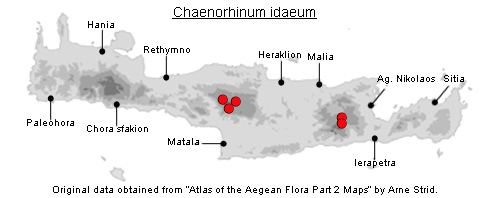SPECIES DESCRIPTION
CHAENORHINUM IDAEUM
Family and Genus:- See- PLANTAGINACEAE
Common Names:- None
Homotypic Synonyms:- Chaenorhinum minus ssp. idaeum, Crorrhinum
idaeum.
Meaning:- Chaenorhinum (Gr) Gaping-nose (analogy with Antirrhinum)
Idaeum (L) From Mount Ida in Crete.
General description:- Annual, with several slender branches between spreading
and erect, the whole plant ± glandular-pubescent.
Stems:-
1) Up to 2-5 cm.
Leaves:-
1) Opposite below and alternate above, 5-35 x 1-5(-8) mm, linear to oblong-
lanceolate, obtuse.
Flowers:-
1) Inflorescence, diffuse, occupying most of the plant.
2) Bracts, leaf-like.
3) Pedicels, 5-15 mm, filiform, erect or ascending.
4) Calyx, 2-2.5 mm; divided almost to the base, with linear-spatulate lobes up to 5
mm, obtuse.
5) Corolla, 5 mm; pale yellow,
a) spur, 1·5-2·5 mm, more or less cylindrical, obtuse.
Fruit:-
1) Capsule, subglobose, shorter than or equalling the calyx, 3-4 mm.
2) Seeds, 0·5-1 mm, with smooth or minutely denticulate ribs.
Key features:-
1) Corolla, 5-9 mm; pale yellow.
2) Capsule, subglobose, shorter than or equalling the calyx,
Habitat:- Clay and gravel in dolines 1700-2300 m.
Distribution:- A rare endemic of dolines at high altitude in the Psiloritis and Dikti
Massifs.
Flowering time:- Jun-July
Photos by:- Zacharias Angourakis
Status:-
Conservation status (for threatened species): Vulnerable (V) according to IUCN
1997.
Protection status (for threatened species): Greek Presidential Decree 67/1981.
